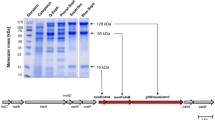Abstract
Washed everted vesicles of the methanogenic bacterium strain Gö1 catalyzed an H2-dependent reduction of the heterodisulfide of HS-CoM (2-mercaptoethanesulfonate) and HS-HTP (7-mercaptoheptanoylthreonine phosphate) (CoM-S-S-HTP). This process was independent of coenzyme F420 and was coupled to proton translocation across the cytoplasmic membrane into the lumen of the everted vesicles. The maximal H+/CoM-S-S-HTP ratio was 2. The tranmembrane electrochemical gradient thereby generated was shown to induce ATP synthesis from ADP+Pi, exhibiting a stoichiometry of 1 ATP synthesized per 2 CoM-S-S-HTP reduced (H+/ATP=4). ATP formation was inhibited by the uncoupler 3,5-di-tert-butyl-4-hydroxy-benzylidene-malononitrile (SF 6847) and by the ATP synthase inhibitor N,N′-dicyclohexylcarbodiimide (DCCD). This energy-conserving system showed a stringent coupling. The addition of HS-CoM and HS-HTP at 1 mM each decreased the heterodisulfide reductase activity to 50% of the control. Membranes from Methanolobus tindarius showed F420H2-dependent but no H2-dependent heterodisulfide oxidoreductase activity. Neither of these activities was detectable in membranes of Methanococcus thermolithotrophicus.
Similar content being viewed by others
Abbreviations
- Δμ H+:
-
transmembrane electrochemical gradient of H+
- CoM-SH:
-
2-mercaptoethanesulfonate
- F420 :
-
(N-l-lactyl-γ-l-glutamyl)-l-glutamic acid phosphodiester of 7,8-didemethyl-8-hydroxy-5-deazariboflavin-5′-phosphate
- F420H2 :
-
reduced F420
- HTP-SH:
-
7-mercaptoheptanoylthreonine phosphate
- DCCD:
-
N,N′-dicyclohexylcarbodiimide
- SF 6847:
-
3,5-di-ert-butyl-4-hydroxybenzylidenemalononitrile
- Mb. :
-
Methanobacterium
- Ml. :
-
Methanolobus
- Mc. :
-
Methanococcus
- MV:
-
methylviologen
- BV:
-
benzylviologen
- MTZ:
-
metronidazole
References
Balch WE, Fox GE, Magrum LJ, Woese CR, Wolfe RS (1979) Methanogens: reevaluation of a unique biological group. Microbiol Rev 43:260–296
Bradford MM (1976) A rapid and sensitive method for the quantification of microgram quantities of protein utilizing the principle of protein-dye binding. Anal Biochem 72:248–254
Bobik TA, Olson KD, Noll KM, Wolfe RS (1987) Evidence that the heterodisulfide of coenzyme M and 7-mercaptoheptanoyl-threoninephosphate is a product of the methylreductase reaction in Methanobacterium. Biochem Biophys Res Commun 149:455–460
Deppenmeier U, Blaut M, Gottschalk G (1989) Dependence on membrane components of methanogenesis from methyl-CoM with formaldehyde or molecular hydrogen as electron donors. Eur J Biochem 186:317–323
Deppenmeier U, Blaut M, Mahlmann A, Gottschalk G (1990a) Membrane-bound F420H2-dependent heterodisulfide reductase in methanogenic bacterium strain Gö1 and Methanolobus tindarius. FEBS Lett 261:199–203
Deppenmeier U, Blaut M, Mahlmann A, Gottschalk G (1990b) Reduced coenzyme F420: heterodisulfide oxidoreductase, a novel proton-translocating redox system in methanogenic bacteria. Proc Natl Acad Sci USA 87:9449–9453
Ellermann J, Hedderich R, Böcher R, Thauer RK (1988) The final step in methane formation-investigations with highly purified methyl-CoM reductase (component C) from Methanobacterium thermoautotrophicum (strain Marburg). Eur J Biochem 171:669–677
Ellman GL (1958) A colorimetric method for determining low concentrations of mercaptans. Arch Biochem Biophys 74:443–450
Hedderich R, Thauer RK (1988) Methanobacterium thermoautotrophicum contains a soluble enzyme system that specifically catalyzes the reduction of the heterodisulfide of coenzyme M and 7-mercaptoheptanoylthreonine phosphate with H2. FEBS Lett 234:223–227
Hedderich R, Berkessel A, Thauer RK (1989) Catalytic properties of the heterodisulfide reductase involved in the final step of methanogenesis. FEBS Lett 255:67–71
Hedderich R, Berkessel A, Thauer RK (1990) Purification of heterodisulfide reductase from Methanobacterium thermoautotrophicum (strain Marburg). Eur J Biochem 193:255–261
Hippe H, Caspari D, Fiebig K, Gottschalk G (1979) Utilization of trimethylamine and other methyl compounds and methane formation by Methanosarcina barkeri. Proc Natl Acad Sci USA 76:494–498
Jussofie A, Gottschalk G (1986) Further studies on the distribution of cytochromes in methanogenic bacteria. FEMS Microbiol Lett 22:15–18
Kimmich GA, Randles J, Brand JS (1975) Assay of picomole amounts of ATP, ADP and AMP using the luciferase enzyme system. Anal Biochem 69:187–206
König H, Stetter KO (1982) Isolation and characterization of Methanolobus tindarius, sp. nov., a coccoid methanogen growing only on methanol and methylamines. Zbl Bakteriol Hyg I. Abt Orig C 3:478–490
Kühn W, Fiebig K, Hippe H, Mah RA, Huser BA, Gottschalk G (1983) Distribution of cytochromes in methanogenic bacteria. FEMS Microbiol Lett 20:407–410
Livingston DJ, Fox JA, Orme-Johnson WH, Walsh CT (1987) 8-Hydroxy-5-deazaflavin-reducing hydrogenase from Methanobacterium thermoautotrophicum. 2. Kinetic and hydrogen-transfer studies. Biochemistry 26:4228–4237
Ma K, Thauer RK (1990) Purification and properties of N-5,N-10-methylenetetrahydromethanopterin reductase from Methanobacterium thermoautotrophicum (strain Marburg). Eur J Biochem 191:187–193
Mayer F, Jussofie A, Salzmann M, Lübben M, Rhode M, Gottschalk G (1987) Immunoelectron microscopic demonstration of ATPase on the cytoplasmic membrane of the methanogenic bacterium strain Gö1. J Bacteriol 169:2307–2309
Peinemann S, Hedderich R, Blaut M, Thauer RK, Gottschalk G (1990) ATP synthesis coupled to electron transfer from H2 to the heterodisulfide of 2-mercaptoethanesulfonate and 7-mercaptoheptanoylthreonine phosphate in vesicle preparations of the methanogenic bacterium strain Gö1. FEBS Lett 263: 57–60
Yamazaki S, Tsai L (1986) Purification and properties of 8-hydroxy-5-deazaflavin-dependent NADP+ reductase from Methanococcus vannielii. J Biol Chem 255:6462–6465
Author information
Authors and Affiliations
Rights and permissions
About this article
Cite this article
Deppenmeier, U., Blaut, M. & Gottschalk, G. H2: heterodisulfide oxidoreductase, a second energy-conserving system in the methanogenic strain Gö1. Arch. Microbiol. 155, 272–277 (1991). https://doi.org/10.1007/BF00252211
Received:
Accepted:
Issue Date:
DOI: https://doi.org/10.1007/BF00252211




